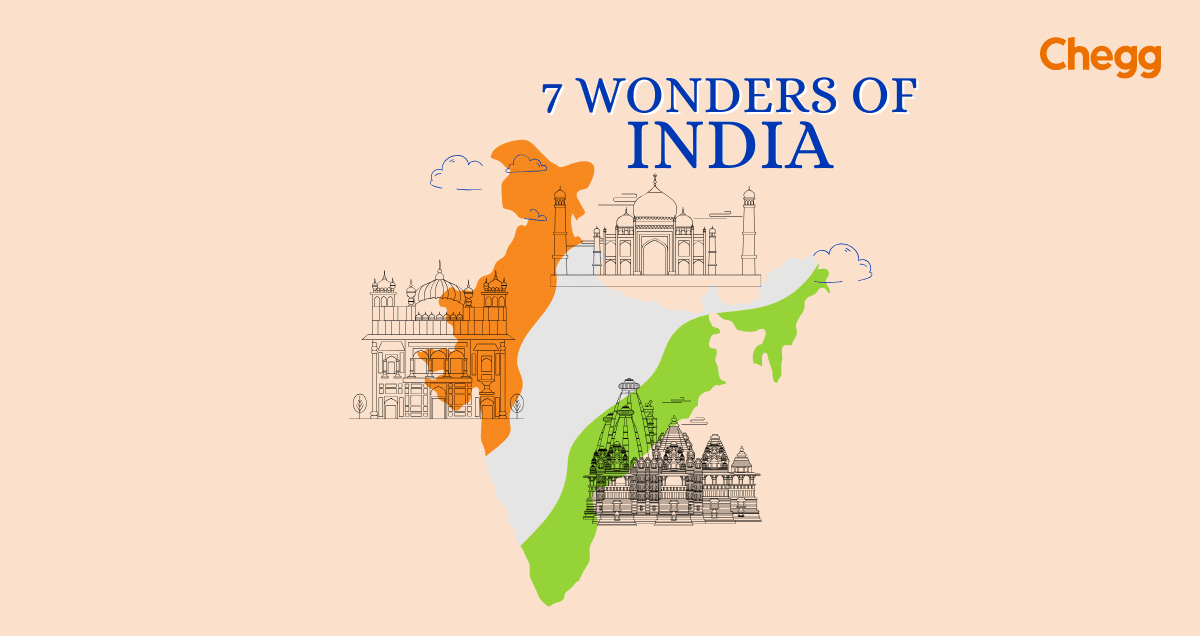
Quick Summary
Table of Contents
India, renowned for its vast cultural diversity and varied ways of life, has been shaped by numerous civilizations and dynasties throughout its history. The 7 Wonders of India list epitomizes this rich diversity, representing our ancestors’ exceptional creativity and innovation through their remarkable architectural achievements.
The 7 wonders of India were designated to honor and preserve these historic landmarks for future generations. While they are crucial in illustrating India’s architectural evolution, they are vital to understanding its cultural and historical heritage.
India’s illustrious past has endowed us with magnificent palaces, extraordinary temples, mosques, and other sacred sites. The grandeur of these structures reflects intricate craftsmanship and meticulous architectural design, offering insights into our ancestors’ lives, beliefs, and cultural practices.
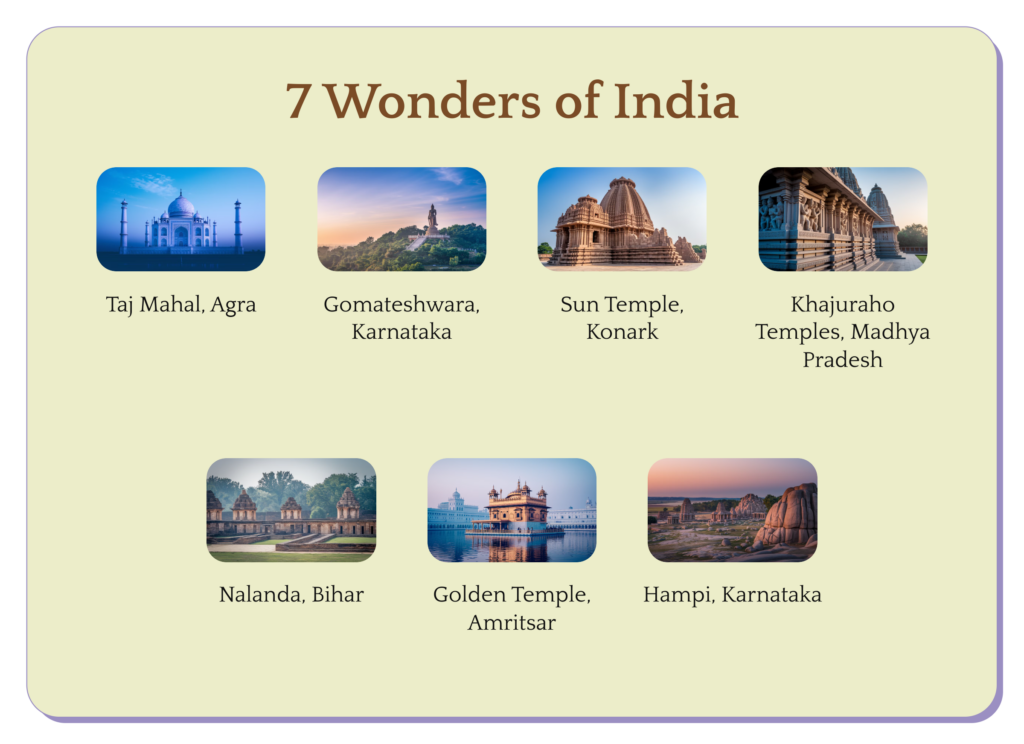
Each monument listed in the 7 Wonders of India has profound historical significance, reflecting the country’s rich cultural heritage and architectural prowess. These structures tell stories of India’s diverse dynasties and civilizations. They exemplify bygone eras’ artistic and engineering skills, showcasing intricate designs, craftsmanship, and innovation.
Beyond their architectural beauty, The 7 Wonders of India, chosen to represent the country’s rich heritage, also serve as symbols of the socio-political and religious history of the regions, providing valuable insights into the lives and beliefs of past societies.
In India, monuments and wonders across different regions showcase diverse architectural styles and cultural influences, reflecting the country’s rich history of various civilizations. For example, Dravidian architecture is prominent in the ancient temples and buildings of South India, while North India features renowned examples of Indo-Islamic architecture. The 7 Wonders of India highlight the beauty and grandeur of these cultural treasures, each symbolizing India’s architectural brilliance.
Also Read Ancient Architecture in India: Style, Types, Characteristics.
As listed by UNESCO, India has one of the highest number of World Heritage Sites. Out of these Heritage Sites, the Ministry of Culture has picked 7 sites as the 7 wonders of India. Each site signifies a specific period of Indian history and showcases that period’s beliefs, architecture, and culture.
Read the criteria used to pick the 7 wonders of India below:
This list presents the 7 wonders of India that are chosen based on their historical significance:
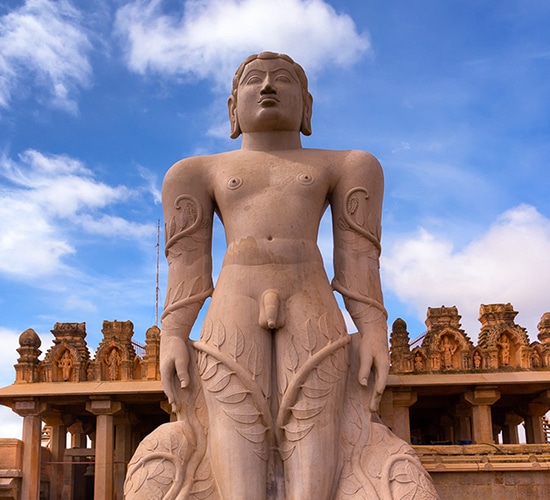
Gomateshwara Statue, also called the Bahubali Temple, dates back to 983 AD. It is located in the village of Shravanabelagola and is India’s largest monolithic statue. Sculptors carved the sculpture from a single block of granite. It stands 57 feet tall and is visible from at least 30 kilometers away, above the village’s Vidhyagiri hill. Gomateshwara is an essential figure in the history of Jainism, being the second son of the first Tirthankara of Jainism.
Voted as one of the 7 wonders of India in 2007, the statue symbolizes non-violence.
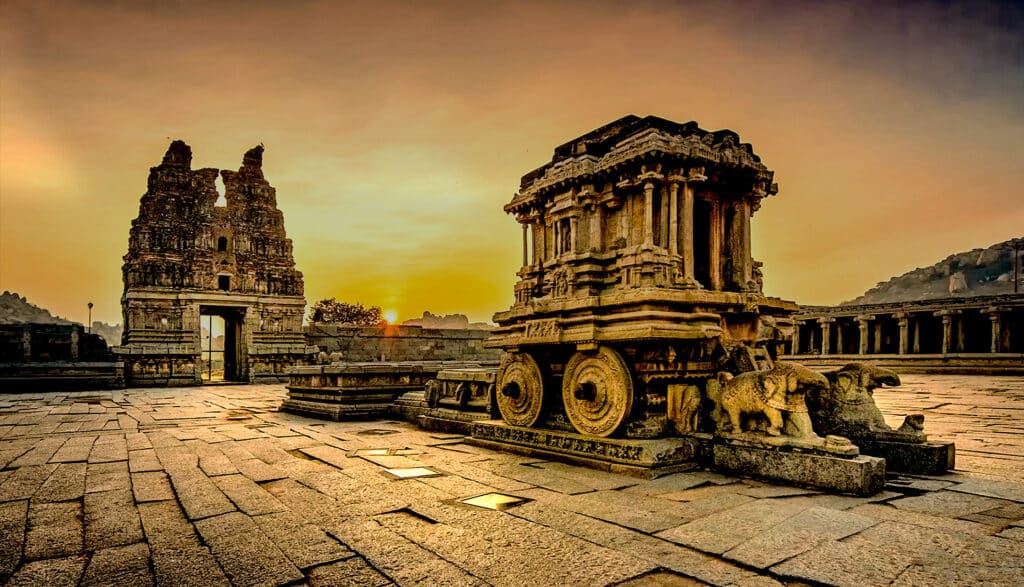
Hampi, one of the 7 Wonders of India, was the capital of the majestic Vijayanagara Empire, the last great Hindu Kingdom. Spread over 4187 hectares, the city’s ruins are located in modern India’s Bellary district of Karnataka, by the Tungabhadra basin.
The most prominent structures remaining are the Krishna Temple Complex, Achyutaraya Temple Complex, Vitthala Temple Complex, Lotus Mehal Complex, Pattabhirama Temple Complex, etc.
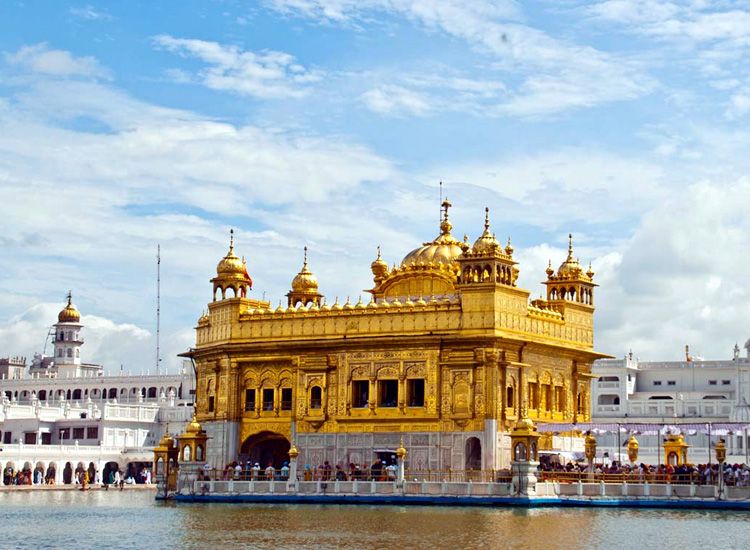
Harmandir Sahib, more commonly known as the Golden Temple or Darbar Sahib, is one of the 7 Wonders of India and serves as the chief Gurdwara for Sikhs. It is located in Amritsar, Punjab. Guru Arjan Dev Ji, the fifth Guru of Sikhs, built the gurdwara in 1604. He intentionally constructed it on a lower level, ensuring everyone entering would have to step down to enter it.
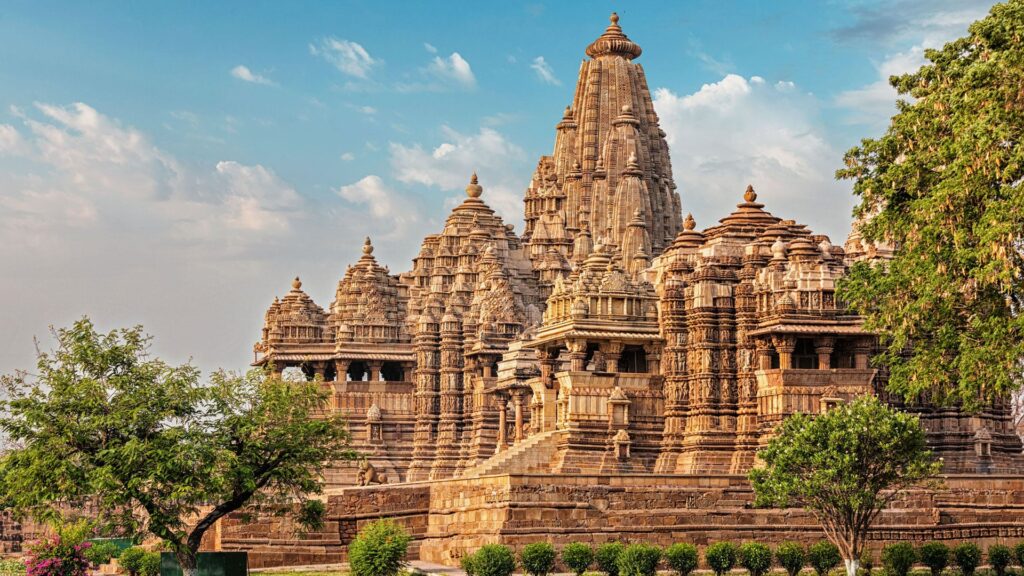
Khajuraho, one of the 7 Wonders of India, is a stunning complex of 23 temples that showcase the unique North Indian architecture of the Chandella dynasty. Built between the 9th and 10th centuries, these temples exemplify the Nagara style of architecture. By the 12th Century, the complex had 85 temples, of which only 23 have survived.
Chinese pilgrim Xuanzang first mentioned Khajuraho in his journals in 641. After the fall of the Chandela dynasty, these temples suffered great destruction due to the continuous onslaught of invaders.
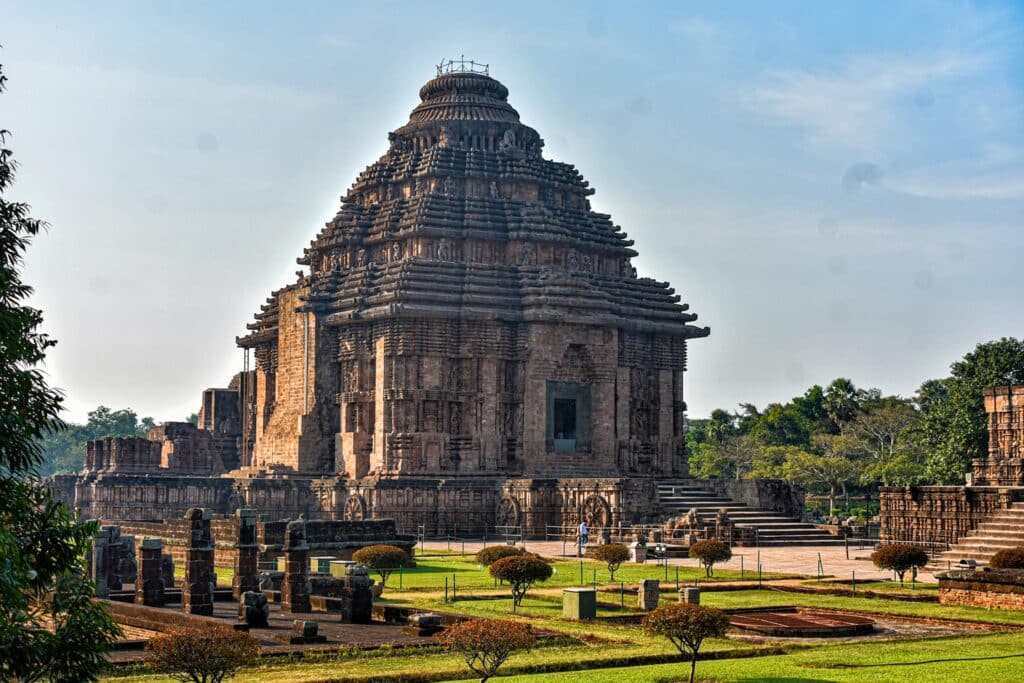
The Konark Sun Temple, one of the “7 Wonders of India,” is located in the village of Konark, around 35 km from Puri, Odisha. It is a testament to the worship of the sun, a practice followed since the 19th Century BC. Built in the 13th Century under the rulers of the Eastern Ganga dynasty, the place signifies the holy seat of Surya or the Sun.
The temple has intricate carvings of dancers, animals, musicians, etc. It also shows horses and the wheels of the chariot of the Sun God. Over the years, the temple has been subject to desecration and damage, particularly of the 200-foot-high Shikhara next to the chariot.
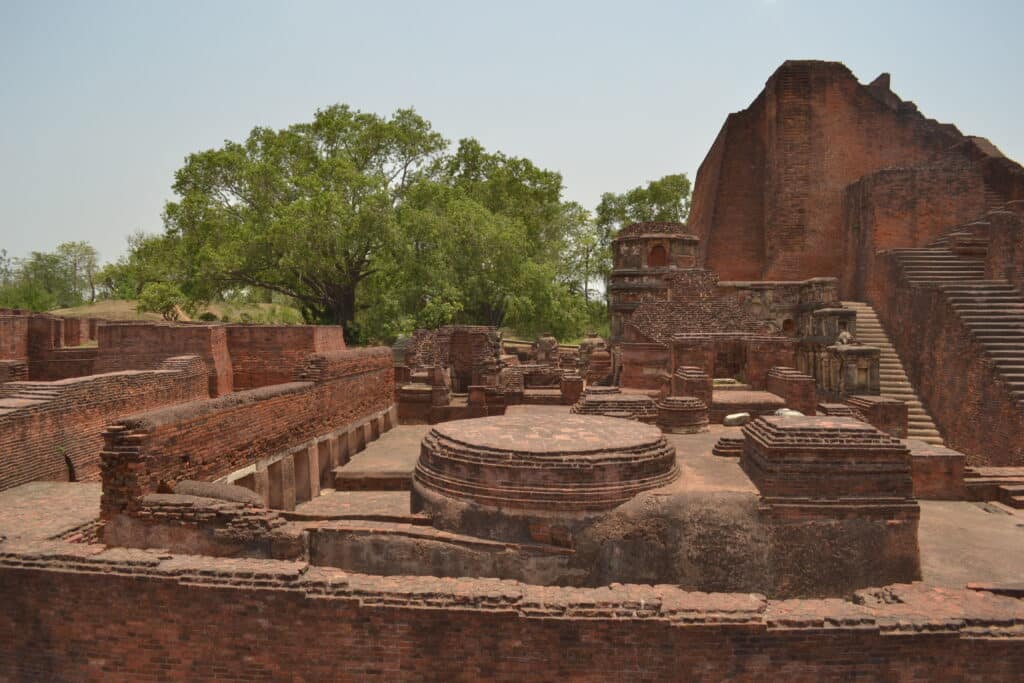
Nalanda Mahavihara, or Nalanda University, was a famous university of the ancient Magadha empire. It is located in Rajgir, Bihar, and is deemed the first residential university in the world. The university operated between the 5th and 12th centuries and was a symbol of the Golden Age of India.
The university is now a UNESCO World Heritage Site. However, it remained in operation for centuries after its destruction. It is the oldest of the 7 wonders of India.
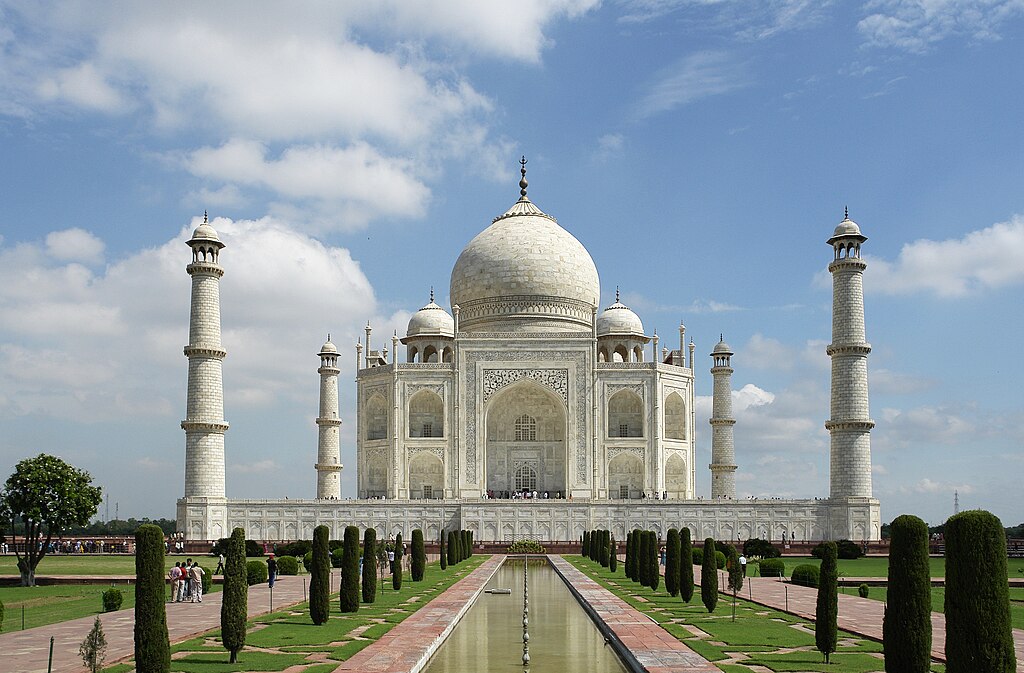
Shah Jahan, the fifth ruler of the Mughal dynasty, built the Taj Mahal in medieval India as a great symbol of love. He built it as a mausoleum for his wife and the love of his life, Mumtaz Mahal. The Taj Mahal is not only one of the 7 wonders of India but also one of the 7 wonders of the world.
The Mughal emperor Shah Jahan built the mausoleum of white marble on the banks of Yamuna in Agra, Uttar Pradesh. Completing the intricate, vast structure took 16 years and 20,000 artisans. Ustad Ahmad Lohri worked as the leading architect of the Taj Mahal, along with various dome builders, carvers, inlayers, painters, and stone cutters.
Learn the architectural significance of the 7 wonders of India below:
This statue, one of the 7 Wonders of India, is a marvelous feat of art, with its intricate carvings and plants that cover the sculpture. A giant stone supports the statue. The sculptor designed the statue with its arms pointing downwards and face upright, facing north in Kayotsarga. The statue also depicts the Jain belief of Digambar (the practice of nudity), which signifies that a person has renounced earthly desires and attachments to attain divinity.
Today, the city, recognized as one of the 7 Wonders of India, is home to 1600 surviving remains built between the 14th and 16th centuries. These include temples, forts, stables, Mandapas, pillared halls, royal complexes, riverside features, and more.
These complexes boast the alluring Dravidian style of architecture, which is evident in their huge pillars and massive dimensions.
Additionally, the city boasts a multi-religious and multicultural society through the representation of Indo-Islamic architecture. The Queen’s Bath and Elephant Stables are examples of this style of architecture in the city. The city maintained its position as a metropolitan of the country, after which it was partially destroyed in the Battle of Talikota.
The Gurudwara, one of the seven Wonders of India, symbolizes unity and inclusivity. With openings on all four sides, it is open to worshippers of every caste and creed.
However, the original temple was destroyed multiple times by invaders. Maharaja Ranjit Singh rebuilt it during the early 19th Century, using marble and copper and covering it with a gold foil.
These temples, recognized as one of the 7 Wonders of India, showcase intricate structures with deep symbolism and exemplify the artistry of ancient India. The temple was long forgotten and inside an overgrown jungle until 1838, when a British engineer rediscovered it. The monuments were included in the UNESCO World Heritage List in 1986. It is a group of Hindu and Jain temples in Madhya Pradesh with erotic sculptures and artwork.
This temple, recognized as one of the 7 Wonders of India and a UNESCO World Heritage Site, signifies Kalinga architecture. The primary elements of this style of architecture are:
The image of the Sun is present at the Garbhagriha, or the sanctum sanctorum. It is said that the architecture was very concise, to the extent that the first ray of the rising sun fell on the God statue inside the Garbhagriha.
Developed during the Gupta period, the University, often considered one of the 7 Wonders of India, boasted a faculty of some of the most outstanding scholars of the time. It was the primary source of sacred Sanskrit texts that Chinese travelers propagated in the 7th Century.
The university compound included various monasteries, temples, stupas, classrooms, meditation halls, and more. However, the main attraction was the library, Dharma Gunj, a multistoried collection of buildings.
The Taj Mahal, one of the 7 Wonders of India, boasts Indo-Islamic architecture and fascinating symmetry renowned worldwide. The complex includes the main gateway, mosque, garden, jawab (the building that mirrors the mosque), the mausoleum, and four minarets.
India treasures historical sites and buildings that showcase its rich history and culture. From the palaces of Rajasthan to the caves in Maharashtra and the Dravidian temples of Karnataka, India hosts a variety of cultures and architecture.
However, these sites and structures are deteriorating because of rising pollution, urbanization, and other harmful human activities. It is essential to conserve these sites so future generations can experience the history and variety of cultures India has birthed and fostered.
These cultural sites are still seen as focal points of our communities. They invoke the feeling of togetherness and belonging in people’s hearts.
Historic buildings are the focus of cultural tourism. They boost the country’s economy by attracting tourists who wish to visit the ancient cultural sites.
These buildings are a direct mirror of our past and ancient civilizations. They teach us about the culture, beliefs, practices, architectural designs, etc., followed during those times.
The concept of the “Seven Wonders of the World” has captivated travelers and history buffs for millennia. These awe-inspiring structures represent the pinnacle of human ingenuity and artistry from various eras. Explore the ancient and modern 7 Wonders of the World below:
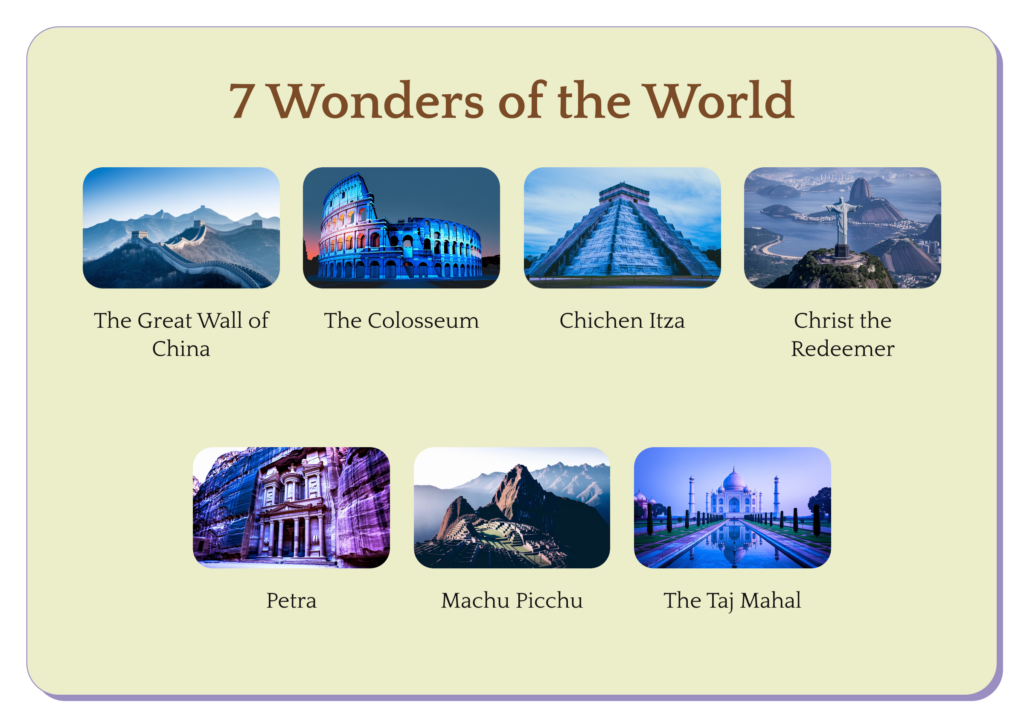
The fascinating Waste to Wonder Park in New Delhi, India, features replicas of the iconic Seven Wonders of the World created from industrial and other waste materials. This innovative theme park combines environmental consciousness with awe-inspiring monuments:
The park showcases replicas of the following iconic monuments 7 Wonders Of The World:
Waste to Wonder Park combines art, environmental consciousness, and global heritage, making it a must-visit attraction for locals and tourists. Learn more about “7 Wonders of the World Park” here.
From the incredibly detailed Gomateshwara Statue to the grand Taj Mahal, each of the 7 Wonders Of India has a unique tale regarding its history, beliefs, and architectural skills. As we admire these spectacular buildings, it is crucial to understand how vital it is to protect and honor them. By caring for these treasures, we ensure that future generations can experience and learn from the rich culture that makes India unique.
Also Read:
Preserving these sites is crucial for maintaining India’s cultural identity, promoting tourism, and enriching education.
The Gomateshwara Statue signifies the Jain practice of Digambar, along with the virtues of peace, non-violence, and simplicity.
Nalanda University faced multiple attacks from neighboring dynasties at the end of the 12th Century.
The Konark Sun Temple is considered one of the seven wonders of India. However, it is not listed among the seven wonders of the world.
7 wonders of India are:
-Taj Mahal – Agra, Uttar Pradesh.
-Golden Temple – Amritsar, Punjab.
-Hampi – Karnataka.
-Sun Temple – Konark, Odisha.
-Khajuraho Temples – Madhya Pradesh.
-Nalanda University – Bihar.
-Gomateshwara Statue – Karnataka.
The term “7 Wonders of India” is used to highlight 7 of the most impressive and historically significant sites in India. These sites are chosen for their cultural, historical, or architectural significance, and they reflect the country’s rich heritage.
The Konark Sun Temple in Odisha is renowned as the Wonder Temple of India for its stunning architecture and intricate carvings.
The Swaminarayan Akshardham Temple in Delhi is often regarded as the 8th wonder of India. It was crafted in just five months and is one of the most stunningly carved temples in India.

Authored by, Amay Mathur | Senior Editor




Amay Mathur is a business news reporter at Chegg.com. He previously worked for PCMag, Business Insider, The Messenger, and ZDNET as a reporter and copyeditor. His areas of coverage encompass tech, business, strategy, finance, and even space. He is a Columbia University graduate.
Editor's Recommendations
Chegg India does not ask for money to offer any opportunity with the company. We request you to be vigilant before sharing your personal and financial information with any third party. Beware of fraudulent activities claiming affiliation with our company and promising monetary rewards or benefits. Chegg India shall not be responsible for any losses resulting from such activities.
Chegg India does not ask for money to offer any opportunity with the company. We request you to be vigilant before sharing your personal and financial information with any third party. Beware of fraudulent activities claiming affiliation with our company and promising monetary rewards or benefits. Chegg India shall not be responsible for any losses resulting from such activities.